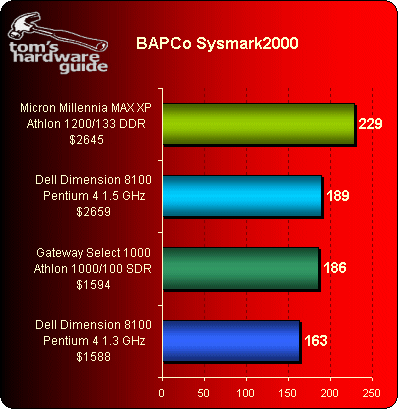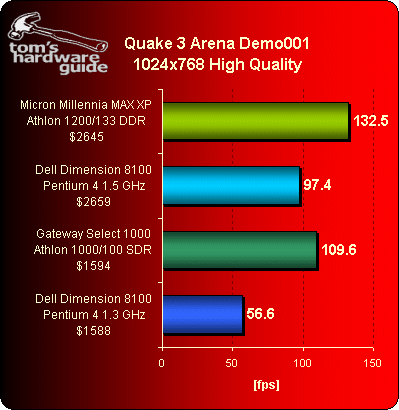Pentium 4 Systems: To Buy or Not To Buy / To Cry Or Not to Cry
Feature Comparison, Continued
| Header Cell - Column 0 | Dell Dimension 8100CustomizedPentium 4 1.5 GHz$2659 | Micron Millennia MAX XPCustomizedAthlon 1.2 GHz$2645 |
|---|---|---|
| Processor | Intel Pentium 1.5 GHz | AMD Athlon 1.2 GHz(266 MHz FSB) |
| Memory | 128 MB PC800 RDRAM | 128 MB PC2100 DDR-SDRAM |
| Hard Drive | 80 GB | 2 x 40 GB RAID0/1 |
| CDROM/DVD | 12x DVD | 12x10x32x8x CD-RW/DVD Combo |
| Graphics Card | NVIDIA GeForce2 GTS 32 MB | NVIDIA GeForce2 Ultra 64 MB |
| Sound Card | Soundblaster Live! Value | Soundblaster Live! Value |
| Modem | V90/56K Telephony | V90/56K PCI |
| Network Card | n/a | SMC 10/100 PCI NIC |
| Monitor | 19" FD Trinitron | 19" Micron OEM |
| Speakers | Harman-Kardon HK-695 Surround Sound w/Subwoofer | Altec Lansing ATP-5 |
| Operating System | Microsoft Windows ME | Microsoft Windows ME |
| Software | Microsoft Works 2001Microsoft Money 2001 StandardNorton Antivirus 2001 | Microsoft Office 2000 Small BusinessTurbo Tax Home and BusinessNorton Antivirus 2001 |
As we go to our $2700 systems the differences between the Pentium 4 and the Athlon system are much more obvious. Micron's equipment list is a pleasure to read. Only the best seems to be good enough for the Millennia MAX XP.
Instead of equipping an only medium-fast 80 GB 5400RPM hard drive from Maxtor, Micron goes for a rather unusual dual-hard disk IDE-RAID solution that gives several different options. If you like it super fast, you can configure the two drives as stripe and benefit from extremely high disk transfer rates. If you are into safety, you can run the two hard disks as mirrors, cutting the capacity in half (40 GB), but ensuring excellent data safety. If you don't trust either solution you can still 'span' the two drives, thus simply making one out of them without the increased risk of data loss of the RAID0 (stripe) configuration.
The combined CD-RW writer and DVD solution of the Millennia MAX XP is obviously better than the DVD-drive only configuration of the Dimension 8100.
Unfortunately Dell's Pentium 4 box would have become too expensive if I would have equipped it with a GeForce2 Ultra card. Micron's Athlon system comes with this top-notch 3D-accelerator and will therefore have a very nice edge over the Dell-system.
Lastly, the Micron PC is actually equipped with a network card, something that the Dell-machine is completely missing. I'd also prefer Microsoft's Office 2000 SB to Microsoft Works 2001 and the Turbo Tax software might be helpful to some of you too. Basically, the Millennia MAX XP benefits from the low price of the processor and is therefore clearly better equipped than Dell's Pentium 4 monster.
The Testing
For this article I chose home / home office systems, which obviously also determines the tests. People who use PCs at home won't run any scientific software or complex rendering application or Photoshop. The typical home/home office PC is used for word-processing, spreadsheets, web browsing, gaming and maybe DVD/Video stuff. Therefore I decided to run Sysmark2000, which tests office application and web browsing performance, Quake 3 Arena and Unreal Tournament to test 3D-gaming performance and Video2000 to test video performance. The two 3D-games were this time ran at a mode that reflects real-world usage. I chose a resolution of 1024x768 and a color depth of 32 bit and therefore a setting that ensures excellent 3D-experience and fun, just as advertised by the OEMs.
Test Setup
Stay on the Cutting Edge
Join the experts who read Tom's Hardware for the inside track on enthusiast PC tech news — and have for over 25 years. We'll send breaking news and in-depth reviews of CPUs, GPUs, AI, maker hardware and more straight to your inbox.
Please remember that we actually SIMULATED the above listed systems, by building almost identical boxes in our lab. This is NOT a test of the actual systems! We used retail motherboards, which are better than the ones used in the OEM boxes and faster hard drives (all 7200RPM). The system configuration used was our default test setup, which is also providing better results than the setup of an OEM box. Basically, our results will be higher than what you can score on those actual systems, but each system got the same advantage/disadvantage.
| Simulated Dell 'Limited Edition' Dimension 8100 Pentium 4 1.3 GHz | |
|---|---|
| Motherboard | Intel D850 GB,BIOS GB85010A.86A.0048.P07 |
| Memory | 128 MB Samsung PC600 RDRAM RIMM |
| Processor | Pentium 4 1.3 GHz |
| Graphics Card | NVIDIA GeForce2 MX 32 MB, Reference Driver Rev. 6.67 |
| Hard Drive | IBM DTLA 307030 7200RPM ATA100 FAT32 |
| Simulated Gateway Select 1000 Athlon 1 GHz | |
|---|---|
| Motherboard | Asus A7V, BIOS 1005C |
| Memory | 128 MB Micron/Crucial PC133 SDRAM DIMM, 2-2-2 |
| Processor | Athlon 1 GHz, 100 MHz FSB |
| Graphics Card | NVIDIA GeForce2 Pro 32 MB, Reference Driver Rev. 6.67 |
| Hard Drive | IBM DTLA 307030 7200RPM ATA100 FAT32 |
| Simulated Dell Dimension 8100 Pentium 4 1.5 GHz | |
|---|---|
| Motherboard | Intel D850 GB,BIOS GB85010A.86A.0048.P07 |
| Memory | 128 MB Samsung PC800 RDRAM RIMM |
| Processor | Pentium 4 1.5 GHz |
| Graphics Card | NVIDIA GeForce2 GTS 32 MB, Reference Driver Rev. 6.67 |
| Hard Drive | IBM DTLA 307030 7200RPM ATA100 FAT32 |
| Micron Millennia MAX XP Athlon 1.2 GHz | |
|---|---|
| Motherboard | Gigabyte GA-7DX, rev. 2.3, BIOS F1 |
| Memory | 128 MB Micron/Crucial PC2100 DDR SDRAM DIMM, 4-2-2-2-2 |
| Processor | Athlon 1.2 GHz, 133 MHz FSB |
| Graphics Card | NVIDIA GeForce2 Ultra 64 MB, Reference Driver Rev. 6.67 |
| Hard Drive | IBM DTLA 307030 7200RPM ATA100 FAT32 |
| Software Setup | |
|---|---|
| Operating System | Windows 98 second edition |
| Desktop Resolution | 1024x768x16x85 |
| Sysmark 2000 version | Patch 4B |
| Quake 3 Arena | Retail version, sound off, 1024x768, High Quality (32 bit color) |
| Unreal Tournament | Retail version, patch 4.28, 1024x768, 32 bit color |
| MadOnion Video2000 | Performance Test Only |
Benchmark Results
Office Application Performance

We know that Pentium 4 performs rather poorly in current office applications, so the two Athlon systems are leaving their equally priced Pentium 4 opponents quite far behind. What is amazing however is the fact that the Gateway Select 1000 Athlon system that costs only $1600 is almost as fast as the $1100 more expensive Dell Dimension 8100 Pentium 4 1.5 GHz in this test. So far about 'cutting edge'.
3D Gaming Performance

Quake 3 Arena shows how much of a difference the graphics card actually makes. In fact, as soon as you are using a higher resolution than 800x600, the processor plays much less of a role than the 3D card. It is quite amusing to see how well the Athlon systems are performing here. Again, Gateway's $1600 Select 1000 is able to outperform Dell's $2700 Dimension 8100 P4 1.5 GHz system with ease. Now we know how different the two companies seem to define 'cutting edge'. You can also see that the 'inexpensive' $1600 Pentium 4 system from Dell is far behind all the other systems. Basically, a Pentium 4 system is one of the worst things to spend $1600 on if you are a 3D-gamer. Pentium 4 (as any other processor) needs a fast (and thus expensive) graphics card or it is lost.
Current page: Feature Comparison, Continued
Prev Page Feature Comparison Next Page 3D Gaming Performance, ContinuedMost Popular

